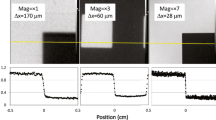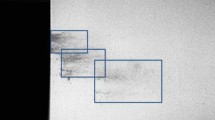Abstract
This paper gives the results of investigation of fast hydrodynamic processes by flash proton radiography based on the U-70 proton synchrotron of the Institute of High Energy Physics (IHEP). The physical setup for proton radiography with a maximum energy of the proton bunch up to 70 GeV and intensity up to 1.5 · 1013 protons per cycle records up to 29 frames in one projection with the minimum interframe time interval of 165 nsec. At present, the recording area is ≈60 mm in diameter, with the prospect of increasing to 250 mm. The duration of the proton bunches equals 20–30 nsec and can be reduced to 10–15 nsec. Since 2004 and up to now, the Russian Federal Nuclear Center-Institute of Experimental Physics (RFNC-VNIIEF), together with IHEP, have performed static and dynamic experiments on this setup to study: the initiation and propagation of detonation in condensed explosives, shockwave propagation in inert materials; hydrodynamic instabilities in metals; dynamic deformation and fracture of liners and plates; spall fracture; the formation of shaped-charge jets and their interaction with obstacles; other applications of physics of the explosion. The proton radiography complex based on the U-70 accelerator and designed by researchers of RFNC-VNIIEF and IHEP is a unique tool for studying fast processes. The method of proton radiography opens up new opportunities for Russian researchers: multiframe recording, almost unlimited thickness of the objects studied, high spatial resolution, enormous dynamic recording range.
Similar content being viewed by others
References
N. A. Zlatin (ed.), Physics of Fast Processes [Russian translation], Vol. 1, Mir, Moscow (1971).
Yu. M. Antipov, A. G. Afonin, A. V. Vasilevskii, et al., “Proton radiographic facility on the 70 GeV accelerator of the Institute of High Energy Density Physics,” Preprint, Institute of High Energy Physics, Protvino (2009).
Yu. M. Antipov, A. G. Afonin, A. V. Vasilevskii, et al., “Radiographic facility of the proton accelerator with an energy of 70 GeV of the Institute of High Energy Density Physics,” Prib. Tekh. Éksp., Nos. 3/5, 5–12 (2010).
Ch. Morris, J. W. Hopson, and Ph. Goldstone, Proton Radiography, Los Alamos Science, No. 30, 32–45 (2006).
Addendum to the Written Statement Submitted to the Strategic Forces Subcommittee of the Senate Armed Services Committee, Los Alamos, April 10 (2002).
The Advanced Hydrotest Facility Overview, Arch Thiessen, Presentation for Snowmass Meeting, LA-UR 01-3742, July 11 (2001).
R. R. Wilson, “Radiological use of fast photons,” Radiology, 47, 487 (1946).
H.L. Anderson, “Neutronic reactor,” U.S. Patent No. 2.953510, Publ. September 20, 1960, Patent Office, Patent Gazette 758, 673.
A. Gavron, C. L. Morris, H. J. Ziock, and J. D. Zumbro, Proton Radiography, Los Alamos National Laboratory document No. LA-UR-96-420 (1996).
M. A. Syrunin, E. D. Vishnevetskii, A. L. Mikhailov, et al., “Localizing device for radiographic studies of explosive processes,” RF Patent No. 2367899 C1, Publ. September 20, 2009, Byull. No. 26.
M. A. Syrunin, E. D. Vishnevetskii, A. G. Fedorenko, and V. A. Chernov, “Blast chamber,” RF Patent No. 2404407 C1, Publ. November 20, 2010, Byull. No. 32.
I. V. Shiberin, Yu. V. Batkov, V. V. Burtsev, et al. “Formation of a cavity in a copper sphere under quasispherical explosive loading,” in: XI Kharitonov Thematic Scientific Readings, Proc. Int. Conf., RFNC-VNIIEF, Sarov (2009), pp. 304–309.
M. Held, “Defeating mechanisms of reactive armor sandwiches,” in: Proc. of 22 Int. Ballistics Symposium, Vancouver, Canada (2005).
A. I. Lebedev, P. N. Nizowtsev, and V. A. Rayevsky, “Rayleigh-Taylor instability in solids,” in: 4th Int. Workshop on the Physics of Compressible Turbulent Mixing, Cambridge, England, 29 March to 1 April (1993), pp. 81–93.
A. I. Lebedev, P. N. Nizowtsev, V. A. Rayevsky, and V. P. Soloviev, “Rayleigh-Taylor instability in strong media. Experimental study,” in: 5th Int. Workshop on the Physics of Compressible Turbulent Mixing, New York, USA, July 18–21 (1995), pp. 231–236.
O. N. Aprelkov, V. V. Igonin, A. I. Lebedev, P. N. Nizovtsev, V. A. Raevsky, et al., “Perturbation method for study of shear strength of materials at pressures up to ∼300 GPa,” in: M. D. Furnish, M. Elert, T. P. Russell, and C. T. White (eds.), Shock Compression of Condensed Matter 2005, American Inst. of Physics, Melville, New York (2006), pp. 745–748.
Author information
Authors and Affiliations
Corresponding author
Additional information
__________
Translated from Fizika Goreniya i Vzryva, Vol. 47, No. 6, pp. 16–28, November–December, 2011.
Rights and permissions
About this article
Cite this article
Burtsev, V.V., Lebedev, A.I., Mikhailov, A.L. et al. Use of multiframe proton radiography to investigate fast hydrodynamic processes. Combust Explos Shock Waves 47, 627–638 (2011). https://doi.org/10.1134/S0010508211060025
Received:
Published:
Issue Date:
DOI: https://doi.org/10.1134/S0010508211060025




